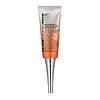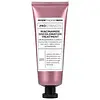What's inside
What's inside
 Key Ingredients
Key Ingredients

 Benefits
Benefits

 Concerns
Concerns

 Ingredients Side-by-side
Ingredients Side-by-side

Water
Skin ConditioningTetrahexyldecyl Ascorbate
AntioxidantPEG-8 Beeswax
EmulsifyingButylene Glycol
HumectantMagnesium Aluminum Silicate
AbsorbentCetearyl Alcohol
EmollientTocopheryl Acetate
AntioxidantGlyceryl Stearate
EmollientPEG-100 Stearate
Ferulic Acid
AntimicrobialIsopropyl Palmitate
EmollientGlycerin
HumectantCeteareth-20
CleansingDimethicone
EmollientAllantoin
Skin ConditioningAloe Barbadensis Leaf Juice
Skin ConditioningAngelica Acutiloba Root Extract
Skin ConditioningDictyopteris Polypodioides Extract
EmollientCitric Acid
BufferingDisodium EDTA
Titanium Dioxide
Cosmetic ColorantMica
Cosmetic ColorantPotassium Bitartrate
BufferingPotassium Sorbate
PreservativeSodium Benzoate
MaskingPhenoxyethanol
PreservativeWater, Tetrahexyldecyl Ascorbate, PEG-8 Beeswax, Butylene Glycol, Magnesium Aluminum Silicate, Cetearyl Alcohol, Tocopheryl Acetate, Glyceryl Stearate, PEG-100 Stearate, Ferulic Acid, Isopropyl Palmitate, Glycerin, Ceteareth-20, Dimethicone, Allantoin, Aloe Barbadensis Leaf Juice, Angelica Acutiloba Root Extract, Dictyopteris Polypodioides Extract, Citric Acid, Disodium EDTA, Titanium Dioxide, Mica, Potassium Bitartrate, Potassium Sorbate, Sodium Benzoate, Phenoxyethanol
Water
Skin ConditioningNiacinamide
SmoothingIsononyl Isononanoate
EmollientDimethyl Isosorbide
SolventTranexamic Acid
AstringentDimethicone
EmollientPropanediol
SolventPentylene Glycol
Skin ConditioningCaprylic/Capric Triglyceride
MaskingAlpha-Arbutin
AntioxidantGlyceryl Stearate
EmollientC9-12 Alkane
SolventCetyl Alcohol
EmollientButyrospermum Parkii Butter
Skin ConditioningCitric Acid
BufferingKojic Acid
AntioxidantMorus Alba Root Extract
BleachingResveratrol
AntioxidantScutellaria Lateriflora Extract
Skin ConditioningHydrangea Arborescens Root Extract
Skin ConditioningSqualane
EmollientHydrolyzed Vegetable Protein
Skin ConditioningPhenoxyethanol
PreservativePEG-100 Stearate
Tocopheryl Acetate
AntioxidantPolyacrylate Crosspolymer-6
Emulsion StabilisingPEG-75 Stearate
Ceteareth-20
CleansingSteareth-20
CleansingSilica
AbrasiveAmmonium Acryloyldimethyltaurate/Beheneth-25 Methacrylate Crosspolymer
Emulsion StabilisingDimethiconol
EmollientCoco-Caprylate/Caprate
EmollientHydroxyethyl Acrylate/Sodium Acryloyldimethyl Taurate Copolymer
Emulsion StabilisingTitanium Dioxide
Cosmetic ColorantSodium Phytate
Diethylhexyl Syringylidenemalonate
Skin ProtectingPotassium Sorbate
PreservativeSodium Benzoate
MaskingPolysorbate 60
EmulsifyingPolysorbate 20
EmulsifyingT-Butyl Alcohol
PerfumingCaprylyl Glycol
EmollientHexylene Glycol
EmulsifyingSorbitan Isostearate
EmulsifyingWater, Niacinamide, Isononyl Isononanoate, Dimethyl Isosorbide, Tranexamic Acid, Dimethicone, Propanediol, Pentylene Glycol, Caprylic/Capric Triglyceride, Alpha-Arbutin, Glyceryl Stearate, C9-12 Alkane, Cetyl Alcohol, Butyrospermum Parkii Butter, Citric Acid, Kojic Acid, Morus Alba Root Extract, Resveratrol, Scutellaria Lateriflora Extract, Hydrangea Arborescens Root Extract, Squalane, Hydrolyzed Vegetable Protein, Phenoxyethanol, PEG-100 Stearate, Tocopheryl Acetate, Polyacrylate Crosspolymer-6, PEG-75 Stearate, Ceteareth-20, Steareth-20, Silica, Ammonium Acryloyldimethyltaurate/Beheneth-25 Methacrylate Crosspolymer, Dimethiconol, Coco-Caprylate/Caprate, Hydroxyethyl Acrylate/Sodium Acryloyldimethyl Taurate Copolymer, Titanium Dioxide, Sodium Phytate, Diethylhexyl Syringylidenemalonate, Potassium Sorbate, Sodium Benzoate, Polysorbate 60, Polysorbate 20, T-Butyl Alcohol, Caprylyl Glycol, Hexylene Glycol, Sorbitan Isostearate
Ingredients Explained
These ingredients are found in both products.
Ingredients higher up in an ingredient list are typically present in a larger amount.
Ceteareth-20 is an emulsifier and cleansing agent. It is derived from cetearyl alcohol, a fatty alcohol.
As an emulsifier, Ceteareth-20 prevents oil and water from separating. It is also a surfactant. Surfactants help gather oil, pollution, and dirt to be washed away.
Citric Acid is an alpha hydroxy acid (AHA) naturally found in citrus fruits like oranges, lemons, and limes.
Like other AHAs, citric acid can exfoliate skin by breaking down the bonds that hold dead skin cells together. This helps reveal smoother and brighter skin underneath.
However, this exfoliating effect only happens at high concentrations (20%) which can be hard to find in cosmetic products.
Due to this, citric acid is usually included in small amounts as a pH adjuster. This helps keep products slightly more acidic and compatible with skin's natural pH.
In skincare formulas, citric acid can:
While it can provide some skin benefits, research shows lactic acid and glycolic acid are generally more effective and less irritating exfoliants.
Most citric acid used in skincare today is made by fermenting sugars (usually from molasses). This synthetic version is identical to the natural citrus form but easier to stabilize and use in formulations.
Read more about some other popular AHA's here:
Learn more about Citric AcidDimethicone is a type of synthetic silicone created from natural materials such as quartz.
What it does:
Dimethicone comes in different viscosities:
Depending on the viscosity, dimethicone has different properties.
Ingredients lists don't always show which type is used, so we recommend reaching out to the brand if you have questions about the viscosity.
This ingredient is unlikely to cause irritation because it does not get absorbed into skin. However, people with silicone allergies should be careful about using this ingredient.
Note: Dimethicone may contribute to pilling. This is because it is not oil or water soluble, so pilling may occur when layered with products. When mixed with heavy oils in a formula, the outcome is also quite greasy.
Learn more about DimethiconeGlyceryl Stearate is a mix of glycerin and stearic acid.
It is used to stabilize the mixing of water and oil ingredients. By preventing these ingredients from separating, it can help elongate shelf life. It can also help thicken the product's texture.
As an emollient, it helps soften skin and supports barrier-replenishing ingredients.
In cosmetics, Glyceryl Stearate is often made from vegetable oils or synthetically produced.
This ingredient may not be fungal-acne safe
Fun fact: The human body also creates Glyceryl Stearate naturally.
Learn more about Glyceryl StearatePeg-100 Stearate is an emollient and emulsifier. As an emollient, it helps keep skin soft by trapping moisture in. On the other hand, emulsifiers help prevent oil and water from separating in a product.
PEGS are a hydrophilic polyether compound . There are 100 ethylene oxide monomers in Peg-100 Stearate. Peg-100 Stearate is polyethylene glycol ester of stearic acid.
Phenoxyethanol is a preservative that has germicide, antimicrobial, and aromatic properties. Studies show that phenoxyethanol can prevent microbial growth. By itself, it has a scent that is similar to that of a rose.
It's often used in formulations along with Caprylyl Glycol to preserve the shelf life of products.
Potassium Sorbate is a preservative used to prevent yeast and mold in products. It is commonly found in both cosmetic and food products.
This ingredient comes from potassium salt derived from sorbic acid. Sorbic acid is a natural antibiotic and effective against fungus.
Both potassium sorbate and sorbic acid can be found in baked goods, cheeses, dried meats, dried fruit, ice cream, pickles, wine, yogurt, and more.
You'll often find this ingredient used with other preservatives.
Learn more about Potassium SorbateSodium Benzoate is a preservative. It's used in both cosmetic and food products to inhibit the growth of mold and bacteria. It is typically produced synthetically.
Both the US FDA and EU Health Committee have approved the use of sodium benzoate. In the US, levels of 0.1% (of the total product) are allowed.
Sodium benzoate works as a preservative by inhibiting the growth of bacteria inside of cells. It prevents the cell from fermenting a type of sugar using an enzyme called phosphofructokinase.
It is the salt of benzoic acid. Foods containing sodium benzoate include soda, salad dressings, condiments, fruit juices, wines, and snack foods.
Studies for using ascorbic acid and sodium benzoate in cosmetics are lacking, especially in skincare routines with multiple steps.
We always recommend speaking with a professional, such as a dermatologist, if you have any concerns.
Learn more about Sodium BenzoateTitanium dioxide is a mineral UV filter widely used in sunscreens and cosmetics.
It is one of only two UV filters officially classified as “mineral” by regulatory agencies, the other being zinc oxide.
Titanium dioxide provides broad-spectrum protection mostly in the UVB and UVAII range, with some protection in the UVAI range.
While its UVA protection isn’t as strong as zinc oxide’s, the difference is minor.
A common myth is that mineral UV filters reflect UV light. However, modern research shows titanium dioxide absorbs UV radiation like chemical filters (~95% absorption & 5% reflection).
Thanks to its non-irritating nature, titanium dioxide is suitable for sensitive, acne-prone, or redness-prone skin. It is unlikely to cause "eye sting" like other sunscreen ingredients.
A major drawback of this ingredient is its white cast and thick texture. This is why mineral sunscreens often leave a white cast and are less cosmetically elegant than chemical/hybrid sunscreens.
To improve white cast and spreadability, micronized or nano-sized titanium dioxide is often used.
There are ongoing concerns surrounding nano-titanium oxide's impact on marine ecosystems.
There is no conclusive evidence that any form of titanium oxide (or any other sunscreen ingredients) will cause harm to marine ecosystems or coral reefs. The science is still developing but many consumers are keeping a close eye on this issue.
Please note, many destinations have reef-safety sunscreen rules. For instance, the U.S. Virgin Islands advises all visitors to use non-nano mineral sunscreens.
Nano mineral sunscreens once raised safety concerns about absorption into skin.
Extensive research has shown that they do not penetrate healthy or damaged skin; they remain safely on the surface and the top layer of dead skin (stratum corneum).
You'll likely find titanium dioxide bundled with alumina, silica, or dimethicone. These ingredients help make titanium dioxide highly photostable; this prevents it from interacting with other formula components under UV light.
Learn more about Titanium DioxideTocopheryl Acetate is AKA Vitamin E. It is an antioxidant and protects your skin from free radicals. Free radicals damage the skin by breaking down collagen.
One study found using Tocopheryl Acetate with Vitamin C decreased the number of sunburned cells.
Tocopheryl Acetate is commonly found in both skincare and dietary supplements.
Learn more about Tocopheryl AcetateWater. It's the most common cosmetic ingredient of all. You'll usually see it at the top of ingredient lists, meaning that it makes up the largest part of the product.
So why is it so popular? Water most often acts as a solvent - this means that it helps dissolve other ingredients into the formulation.
You'll also recognize water as that liquid we all need to stay alive. If you see this, drink a glass of water. Stay hydrated!
Learn more about Water